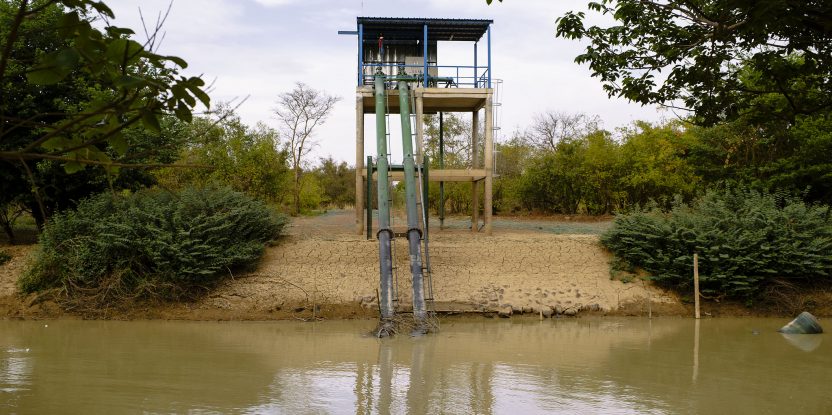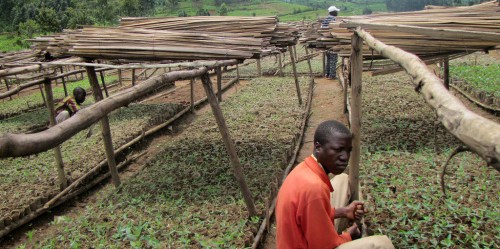
Communities across the globe can build resilience to climate change by re-inventing old water storage strategies and investing in new ones, according to a new book by the International Water Management Institute (IWMI), a member of the CGIAR global partnership, which unites organizations engaged in research for a food secure future.
Combining water storage and savings options often is the most effective way to tackle increasing weather variability, the researchers say. But communities need to weigh trade-offs and be wary of unintended consequences.
Furthermore, obstacles to the efficient use of water include weak governance, the lack of integrated planning, and poor data.
“Water is a scarce resource, but the reality in many river basins across the world is that it also is an inefficiently under-used resource that can be better utilized to offset climate change and ensure food security,” says Jeremy Bird, IWMI’s director-general. “But the challenge is complex and solutions must be tailored to local situations.”
For example, in Rajasthan, India – dubbed the Great Indian Desert – the state government is responding to an inefficient canal system by subsidizing farmers to make farm ponds. The ponds are filled from the Indira Gandhi canal system once a month.
Farmers can then draw water as needed. The storage strategy can be combined with water-saving technologies such as micro-irrigation. “Combining water storage and savings options is one of the most practical, immediate and cost-effective ways to respond to climate-induced water scarcity,” says Vladimir Smakhtin, IWMI’s theme leader on water availability and access.
The research was supported by Climate Change, Agriculture and Food Security (CCAFS) and Water Land and Ecosystems (WLE) research programs of the Consultative Group on International Agricultural Research (CGIAR)
In general, water resources are under increasing pressure in a world where the population has skyrocketed from 2.5 billion in 1950 to 7 billion today, with projections of hitting 9.6 billion by 2050.
Experts generally agree that to feed the world in 2050, crop production will need to grow without significantly expanding farm land, which is under competition from a variety of other users.
In Africa and, to a lesser extent, Asia, insufficient capacity to manage climatic variability lies behind much of the prevailing poverty and food insecurity. Droughts and floods have become more severe over the last half-century.
The more resilient they are, the more they will be able to manage climatic variability, diversify their livelihoods, and reduce their risk
Weather has become more variable, leading to changes in in the patterns and distributions of rainfall, ice and snow melt, soil moisture, and river and groundwater flows. IWMI research shows that while climate-change impacts often have little effect at the basin level, they can have a substantial impact at the sub-basin or local level. Yet, in many countries, irrigation ministries focus on large-scale canal irrigation and dams, and little on other options for storing water, such as in natural wetlands, groundwater aquifers, ponds, and small tanks.
These smaller-scale water storage options have contributed to major increases in crop production in the Mekong Delta, for example, by enabling the use of supplemental irrigation in the dry season. Simple water-lifting equipment – powered by fossil fuels, electricity, the sun, people or animals – and micro-irrigation techniques, ranging from clay pots to drippers, can dramatically boost the ability to cope with climatic variability. Storing water for the dry-season irrigation of rice could improve yields by between 70 percent and 300 percent across sub-Saharan Africa, IWMI researchers estimate.
Overall, about 75 percent of the world’s crops are rainfed, so farming practices such as tried-and-true soil and water conservation are important adaptation strategies. For example, due to the terrain, conventional irrigation is not feasible in the Laotian highlands of the Mekong basin, where population growth is driving the change from shifting cultivation to more intensive cropping. Instead, conservation farming, rainwater harvesting, and storing runoff are useful adaptation strategies. IWMI researchers also have been examining the feasibility of building underground aquifers in certain hot spots of Asia.
An IWMI study of the flood-prone Chao Phraya Basin in Thailand indicated it could be economically feasible to harvest excess river flows to recharge shallow upstream aquifers. Such a scheme, however, would require governments and other institutions to establish payments to the farmers for aquifer recharge, similar to payments for ecosystem services.
To help planners in sub-Saharan Africa, IWMI scientists have developed an analytical tool that evaluates the need for water storage and its likely effectiveness under existing and projected climate conditions. The tool considers reliability, resilience, vulnerability, and the economic, social and environmental aspects of water storage options, as well as trade-offs. It often takes time for governments to set up mechanisms to support water policy changes. In India, a master plan for groundwater recharge was developed in 2005, but major players are still struggling to coordinate their roles.
In Nepal, multiple ministries still must separately approve water policy changes because a new coordinating institute doesn’t yet have the formal authority to do so. Managing climate change also requires transnational cooperation. The Blue Nile Basin in Africa, for example, is an important shared resource of Ethiopia and Sudan and is a main tributary of the Nile in Egypt. While countries have agreed to cooperate, tensions prevail and mechanisms to jointly develop the resources are limited. Planned water storage investments have the potential to perform far better if countries cooperate. Water strategies also involve trade-offs.
In Southeast Asia and Africa, farmers who have adopted rice-intensification practices use less water because they irrigate intermittently instead of flooding paddy fields continuously. Crop yields increase and the environment benefits, but growing rice this way requires more labor, weeding, and attention to water management. “There are very few completely win-win solutions,” says Peter McCornick, IWMI’s deputy director general and head of research.
“In almost every situation, there’s going to be drawbacks or even unintended consequences that will need to be addressed. However, doing nothing is increasingly unlikely to be a viable option.” In the Mekong River Basin, for example, climate change combined with the growth of commercial farming raises concerns about how much water will be available for maintaining aquatic ecosystems. Such ecosystems provide critical nutrition — such as fish, frogs, snails and even insects – to those living there.
A recent IWMI study found that in some areas of Cambodia, the value of fish is higher than the value of rice. Therefore, the intensification of rice production could negatively impact the fish catch unless measures are taken to manage irrigation. Bird added the “unheard” – small-scale farmers, the poor, and women – also need to be given a voice in water policy discussions to ensure equity. Nepal has a strategy for targeting vulnerable groups, women and the disabled.
“But research shows that the low-caste Dalits and indigenous communities have a difficult time accessing climate-change adaptation funds, which are controlled by groups from higher castes,” said Luna Bharati, an IWMI senior researcher and head of the Nepal office. Climate variability calls on the agricultural sector to rethink and refine water storage strategies, understand the role of ecosystems, and develop plans to manage water resources fairly so vulnerable groups aren’t disproportionately harmed. “The changes will require people, communities and societies to be resilient,” Bird said.
“The more resilient they are, the more they will be able to manage climatic variability, diversify their livelihoods, and reduce their risk.” The new book, Tackling change: Future-proofing water, agriculture, and food security in an era of climate uncertainty will be officially launched at the Global Landscapes Forum at the United Nations COP19 climate change conference in Warsaw, Poland, today. *
We want you to share Forests News content, which is licensed under Creative Commons Attribution-NonCommercial-ShareAlike 4.0 International (CC BY-NC-SA 4.0). This means you are free to redistribute our material for non-commercial purposes. All we ask is that you give Forests News appropriate credit and link to the original Forests News content, indicate if changes were made, and distribute your contributions under the same Creative Commons license. You must notify Forests News if you repost, reprint or reuse our materials by contacting forestsnews@cifor-icraf.org.

